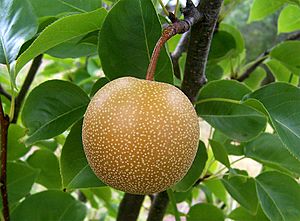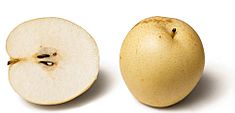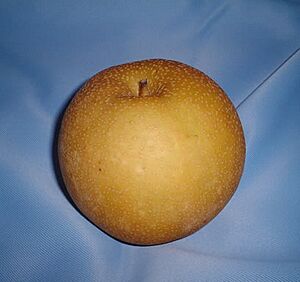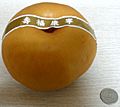Asian pears facts for kids
Quick facts for kids Asian pears |
|
|---|---|
 |
|
| Scientific classification | |
| Genus: |
Pyrus
|
| Species: |
pyrifolia
|
| Synonyms | |
|
List
|
|

Nashi pear (Pyrus pyrifolia)
|
|
| Nutritional value per 100 g (3.5 oz) | |
|---|---|
| Energy | 176 kJ (42 kcal) |
|
10.65 g
|
|
| Sugars | 7.05 g |
| Dietary fiber | 3.6 g |
|
0.23 g
|
|
|
Protein
|
0.5 g
|
| Vitamins | Quantity
%DV†
|
| Thiamine (B1) |
1%
0.009 mg |
| Riboflavin (B2) |
1%
0.01 mg |
| Niacin (B3) |
1%
0.219 mg |
| Pantothenic acid (B5) |
1%
0.07 mg |
| Vitamin B6 |
2%
0.022 mg |
| Folate (B9) |
2%
8 μg |
| Choline |
1%
5.1 mg |
| Vitamin C |
5%
3.8 mg |
| Vitamin E |
1%
0.12 mg |
| Vitamin K |
4%
4.5 μg |
| Minerals | Quantity
%DV†
|
| Calcium |
0%
4 mg |
| Magnesium |
2%
8 mg |
| Manganese |
3%
0.06 mg |
| Phosphorus |
2%
11 mg |
| Potassium |
4%
121 mg |
| Sodium |
0%
0 mg |
|
Link to USDA Database entry
|
|
| †Percentages estimated using US recommendations for adults. | |
Pyrus pyrifolia is a type of pear tree that originally comes from East Asia. The fruit from this tree is known by many names. Some common names are Asian pear, Japanese pear, Chinese pear, Korean pear, and apple pear. You might also hear it called nashi pear or sand pear.
These pears are grown in many places. This includes countries like India, Nepal, Australia, New Zealand, and parts of the United States. In East Asia, the tree's beautiful flowers are a popular sign of early spring. You can often see them in gardens and the countryside.
Asian pears are different from European pears. They have a lot of water and a crunchy, slightly grainy texture. Because of their high water content, they are usually not baked in pies or made into jams. People commonly eat them raw and peeled. The fruit is often quite large and smells nice. If you wrap them carefully, they can stay fresh for several weeks in a cool, dry place. This is because they can bruise easily due to being so juicy.
Contents
Asian Pears in Different Cultures
Asian pears are often quite expensive and large. Because of this, they are usually given as gifts or shared with guests and family.
Cooking with Asian Pears
In cooking, ground Asian pears can be used as a natural sweetener. They are a good replacement for sugar in sauces made with vinegar or soy sauce. They are also great for marinating meat, especially beef. For example, in the Korean dish bulgogi, pear is used to make the meat softer. This happens because the pears have special enzymes that help break down the proteins in the meat.
Asian Pears Around the World
- Australia: Asian pears first started being grown for sale in Australia in 1980.
- Japan: These pears are harvested in many areas of Japan, like Chiba and Ibaraki. The Japanese word for pear is Nashi (梨). This word can be used in haiku poems to describe late autumn. The pear flower, Nashi no hana (梨の花), is a special word for spring. Some cities, like Kamagaya in Chiba, even have the pear flower as their official city flower.
- Nepal and India: In Nepal and the Himalayan parts of India, Asian pears are grown as a crop to sell. They grow well in the Middle Hills, where the climate is just right. The fruit is carried to nearby markets by people or trucks. They don't travel long distances because they can get bruised easily.
- Taiwan: Since 1997, pears from Japan have become popular luxury gifts in Taiwan. People there now buy a lot more of them.
- China: In China, saying "sharing a pear" (Chinese: 分梨; pinyin: fēn lí) sounds like the word for "separate" (simplified Chinese: 分离; traditional Chinese: 分離; pinyin: fēnlí). Because of this, some people avoid sharing a pear with someone they love, as it might suggest they want to separate.
- Korea: In Korea, the fruit is called bae (배). It is grown and eaten a lot there. In the city of Naju, South Korea, there is even a museum dedicated to pears called The Naju Pear Museum and Pear Orchard for Tourists.
- Cyprus: Asian pears were brought to Cyprus in 2010. They are now grown in an area called Kyperounta.
Types of Asian Pears (Cultivars)
Different types of Asian pears are called cultivars. These cultivars are put into two main groups based on their skin color.
- Akanashi (Russet pears): Most Asian pear types belong to this group. They have yellowish-brown skin.
- Aonashi (Green pears): These pears have yellow-green skin.
Here are some important types of Asian pears:
- 'Chojuro' (長十郎, Japan, around 1893) - A Russet pear.
- 'Kosui' (幸水, Japan, 1959) - This is the most important type grown in Japan. It's a Russet pear.
- 'Hosui' (豊水, Japan, 1972) - A Russet pear.
- 'Imamuraaki' (今村秋, Japan, native) - A Russet pear.
- 'Nijisseiki' (二十世紀, Japan, 1898) - Its name means "20th century." This is a Green pear.
- 'Niitaka' (新高, Japan, 1927) - A Russet pear.
- 'Okusankichi' (晩三吉, Japan, native) - A Russet pear.
- 'Raja' (new) - A Russet pear.
- 'Shinko' (新興, Japan, before 1941) - A Russet pear.
- 'Hwangkeum' (황금, 黄金, Korea, 1984) - This type is a mix of 'Niitaka' and 'Nijisseiki'.
- 'Huanghuali' (not to be confused with the wood of Dalbergia odorifera)
Gallery
See also
 In Spanish: Pyrus pyrifolia para niños
In Spanish: Pyrus pyrifolia para niños











